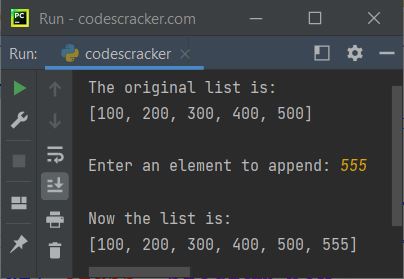- Python Built-in Functions
- Python All Built-in Functions
- Python print() Function
- Python input() Function
- Python int() Function
- Python float() Function
- Python len() Function
- Python range() Function
- Python str() Function
- Python ord() Function
- Python chr() Function
- Python ascii() Function
- Python pow() Function
- Python type() Function
- Python List Functions
- Python list() Function
- Python insert() Function
- Python append() Function
- Python extend() Function
- Python pop() Function
- Python remove() Function
- Python reverse() Function
- Python sort() Function
- Python sorted() Function
- Python Dictionary Functions
- Python dict() Function
- Python update() Function
- Python get() Function
- Python keys() Function
- Python setdefault() Function
- Python fromkeys() Function
- Python items() Function
- Python popitem() Function
- Python Tuple Function
- Python tuple() Function
- Python Set Functions
- Python set() Function
- Python frozenset() Function
- Python String Functions
- Python split() Function
- Python join() Function
- Python format() Function
- Python replace() Function
- Python Iterator Functions
- Python iter() Function
- Python min() Function
- Python max() Function
- Python sum() Function
- Python count() Function
- Python index() Function
- Python copy() Function
- Python clear() Function
- Python next() Function
- Python filter() Function
- Python enumerate() Function
- Python zip() Function
- Python reversed() Function
- Python Number Functions
- Python abs() Function
- Python bin() Function
- Python oct() Function
- Python hex() Function
- Python round() Function
- Python divmod() Function
- Python complex() Function
- Python File Handling Functions
- Python open() Function
- Python read() Function
- Python readable() Function
- Python readline() Function
- Python readlines() Function
- Python write() Function
- Python writable() Function
- Python writelines() Function
- Python close() Function
- Python seek() Function
- Python tell() Function
- Python flush() Function
- Python fileno() Function
- Python truncate() Function
- Python Class Functions
- Python object() Function
- Python property() Function
- Python getattr() Function
- Python setattr() Function
- Python hasattr() Function
- Python delattr() Function
- Python classmethod() Function
- Python staticmethod() Function
- Python issubclass() Function
- Python super() Function
- Python Misc Functions
- Python all() Function
- Python any() Function
- Python isatty() Function
- Python bool() Function
- Python callable() Function
- Python globals() Function
- Python locals() Function
- Python dir() Function
- Python id() Function
- Python isinstance() Function
- Python map() Function
- Python repr() Function
- Python slice() Function
- Python vars() Function
- Python Advance Functions
- Python help() Function
- Python hash() Function
- Python breakpoint() Function
- Python bytes() Function
- Python bytearray() Function
- Python memoryview() Function
- Python compile() Function
- Python eval() Function
- Python exec() Function
- Python Tutorial
- Python Tutorial
- Python Examples
- Python Examples
Python append() Function
The append() function in Python, used to add new element at the end of a list. For example:
mylist = [11, 22, 33, 44, 55] print("Original list is:") print(mylist) mylist.append(66) print("\nNow the list is:") print(mylist)
The output produced by above Python code, illustrating the append() function, is:
Original list is: [11, 22, 33, 44, 55] Now the list is: [11, 22, 33, 44, 55, 66]
Python append() Syntax
Here is the syntax of append() function in Python:
listName.append(new_element)
Python append() Example
Here is an example of append() function in Python. This program is created in a way to append an element entered by user to a list:
mylist = [100, 200, 300, 400, 500] print("The original list is:") print(mylist) print("\nEnter an element to append: ", end="") element = int(input()) mylist.append(element) print("\nNow the list is:") print(mylist)
The snapshot given below shows the sample run of above program, with user input 555 as new element to append:

Note: To insert element at particular or required index, then use insert() function.
Python append() Function - Main Use
When we need to allow user to define the size of a list and with its all elements, then the append() method or function comes into play. Here is an example:
print("How many element to store in the list: ", end="") n = int(input()) print("Enter", n, "elements for the list: ", end="") mylist = [] for i in range(n): val = input() mylist.append(val) mylist = mylist print("\nOriginal list is:") print(mylist) print("\nEnter an element to append: ", end="") val = input() mylist.append(val) print("\nNow the list is:") print(mylist)
Here is its sample run with user input 5 as number of element to store, p, y, t, h, o as five elements, and n as an element to append:

Note: The input() function treats every input value as string type. If you want to work with integer values, then use int(input()).
Python append() Function - Appending List to another List
Because Python allows nested list, therefore a list can be appended to another list using the append() function. Here is an example:
listOne = [1, 2, 3] listTwo = [4, 5, 6] print(listOne) listOne.append(listTwo) print(listOne)
This program produces following output:
[1, 2, 3] [1, 2, 3, [4, 5, 6]]
Note: To append multiple items, instead of appending a list, to avoid creating nested list. Then Python provides another function, that is extend().
« Previous Function Next Function »